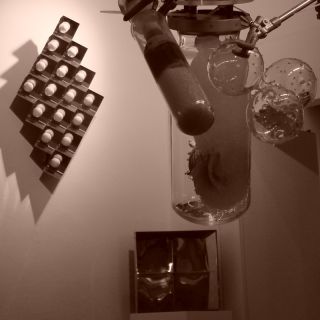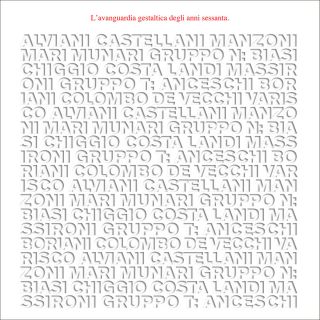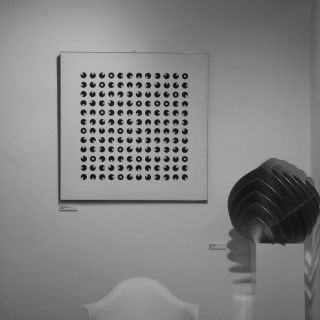Chiggio Ennio
Ennio Chiggio was born in Naples in 1938.
He has completed technical studies and then works in Venice, where he frequents with discontinuity the Academy and the Faculty of Architecture. During his studies in 1957, he began painting using small informal graphic shrinkage with black china on paper and tempered compositions with chromatic fields surrounded by black markings on cardboard. At that time his interests change and develop rapidly.
In 1958-59 he attended a group of young Paduan artists who followed the free courses at the studio of Prof. Travaglia, a professor who was open to the latest trends in contemporary art and architecture.
Some of these students founded in 1959 in Padua the EnneA Group to which Chiggio joins. At first it is an enlarged group of young people who seek to follow the local artistic events and somehow attending the various artwork contests in public procurement. These first necessities, which also underlined more substantive problems, are progressively on the light; the goals are specified and then the group ends up with five elements (Group N). Informal gesture is overcome in order to adhere to more structured formal compositions in a constructivist sense with a greater focus on form psychology. These choices are stimulated by Massironi and Biasi through the exhibitions organized in Padua with the operating modes of the Motus artists and the encounters with Castellani and Manzoni in Milan at the Azimut. Chiggio, positively influenced by such visual structures, begins to operate on sequential and repetitive spaces by developing the phenomenal component of the artistic act. Since the founding of the Enne Group until 1964, strongly motivated by collective action, it acts within the group's visual research even during the absence of military service, informed by Biasi and Costa on group activities through a copious correspondence.
When returning to Padua, he increasingly defines the operational scope by building "objects" obtained by folding and cutting black cards, as a structure of perceptual material able to overcome the random pictorial of the informal framework.
He considers the exchange of information with the international artists in the New Trends and the unrepeatable atmosphere of the meetings with the critic Matko Mestrovic in Padua and then in Zagreb as well, for his artistic formation. Almir Mavignier, known in the New Trends and attended Toni Costa during his Patavini stays, makes mediator Thomas Maldonado for the group's show at Studio F of Ulm.
In 1964 Chiggio founded with Teresa Rampazzi the Group of Experimental Phonology NPS (New Proposals Sound) for the production of sound objects (Electronic Music). It opens a studio equipped with equipment for the production of synthetic sound events which also cares for the theoretical aspect and the notation system. Some of Chiggio's NPS's objects are sound in both the Enne Group's section at the XXXII Venice Biennale in 1964 and the Retrospective at the Museum of Modern Art in Lodz in 1967. This activity puts Chiggio and the other NPS components in contact with Other famous European avant-garde labs with which they perform musical events auditions until 1977.
In 1980, Chiggio, who began his teaching at the Venice Academy in 1978, further deepens his semiologic research around the art declarations, investigating the behaviors of the historic avant-gardes. Continuing the significant experience of opening meeting points and workshops, he opens in Padua with Giulia Laverda, the TOT gallery, for which he cares for exhibitions on the radical trends of contemporary design such as Ultramobile, Memphis, Alchemy, Gufram, as well as Concettual installations and research On the performativity of the playful language of the TATA group, founded with the architects Baruffi, De Santi, Rigo, Pavan, Zambon, the artists Garner, Pardini and the art critic Ernesto Luciano Francalanci, with which he joins in a long fellowship both didactic and critical. This activity begins with the publication of the volume "Del Ludico" published by Mazzotta and continues with a series of books published by the Edizioni Tot. The collective experience of the Ludici concludes in 1988. The work of Ernesto L. Francalanci Lecturer in Venice and Annamaria Sandonà of the University of Padua. Since the early years of his artistic work, Chiggio has fostered visual research with other productive activities in the act not only of filling the economic vacuum produced by the stubborn refusal to participate in the "kermesse" of the artistic market but also deeply motivated by the awareness of the limits of an artistic self-referential work.
From 1964 to 1977, as a professional, he opened a design studio that operates in Italy and abroad in the electromechanical, furniture, lighting, glasses and light prefabrication sectors (SMAU award for the Solaris watch). He actively contributes to the definition of the professional figure of the designer at Milan's Industrial Design Association, where he participated in the Board of Directors in 1973 and represented the Italian design at the ICSID International Symposium in Kyoto with Enzo Mari.
From 1975 to 1991, he has the artistic direction for Italian and foreign companies.
The experience accumulated in the semiological field during the years of teaching, lead him to coordinate between 1978-81 Seminars on Reproduced Image and Illustration at Lucca Comics. He became editor of the first Annals of Italian Literature for the publisher Q. In 1996 he opened in Padua the multimedia laboratory "Embtool" where he conducted e-digital researches with attention to digital video. In this structure he performs documentaries and short films on architecture and art with the collaboration of Alberta Ziche. In 1999 he designed a catalog (Skira edizioni) and the exhibition "MIR" for the Museum of Bolzano, edited by Ernesto L. Francalanci and Roberto Masiero. In 2003 he was curator of Virginia Baradel and Roberto Masiero of the "La Grande Svolta" exhibition at the Palazzo della Ragione in Padua, where he also deals with image coordination. As for the list of individual and collective exhibitions up to 1976, reference can be made to what is present in Italo Mussa's book about the Enne Group. After that date, the dates and references of all the events dedicated to the group are valid.
As for the list of solo and group exhibitions up to 1976, reference can be made to what is present in the fundamental monograph of Italo Mussa, “Gruppo N. La situazione dei gruppi in Europa negli anni ‘60”, Bulzoni Editore, 1976.
After that date, the dates and references of all the events devoted to the group apply with reference to the new important volume GRUPPO N, Silvana Editoriale, 2009.











 L'invadenza della tecnologia, l'impossibilità di evitarla - Getulio Alviani?, Joel Stein vs Enrico T. De Paris
L'invadenza della tecnologia, l'impossibilità di evitarla - Getulio Alviani?, Joel Stein vs Enrico T. De Paris ITALIAN ZERO/CROSS REFERENCE
ITALIAN ZERO/CROSS REFERENCE L'AVANGUARDIA GESTALTICA DEGLI ANNI SESSANTA _ CINQUANT’ANNI DOPO
L'AVANGUARDIA GESTALTICA DEGLI ANNI SESSANTA _ CINQUANT’ANNI DOPO Leggere dagli anni sessanta: da Milano al gruppo N di Padova
Leggere dagli anni sessanta: da Milano al gruppo N di Padova